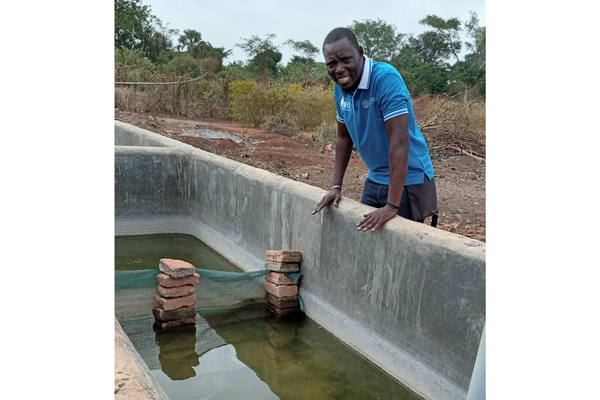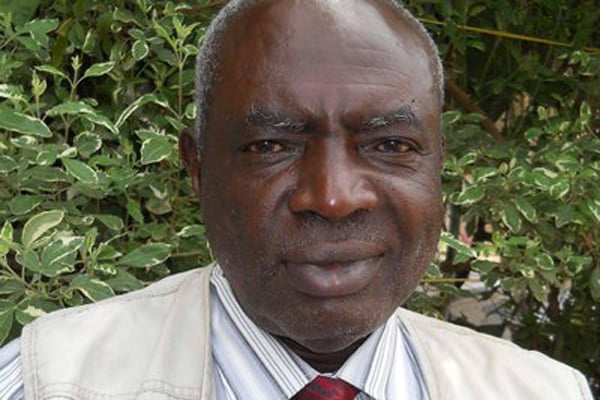Ebuku’s fortunes come from fish farming

Ebuku explains how he earns from fingerlings. Photo | Lominda Afedraru
What you need to know:
- There is a consensus in academic and policy literature about the potential benefits of fish farming, particularly nutrition and income generation.
Agricultural extension services are critical to the development of crops, livestock and fish farming.
Fish farming, though introduced more than 50 years ago through research and extension, remains at a slow pace of growth particularly in northern Uganda.
There is a consensus in academic and policy literature about the potential benefits of fish farming, particularly nutrition and income generation.
As such agricultural scientists at the National Agricultural Research Organisation (Naro) under their project Development Initiative for Northern Uganda (Dinu) are currently implementing projects with farmers in northern Uganda in adoption of various commodities including aquaculture fish farming. The scientists are led by Dr Alfred Komakech from Ngetta Zardi.
The programme aimed at diversifying food systems for food and nutrition security, poverty reduction and inclusive development involves adoption and production of diverse food crops and animal products targeting: diary livestock, fish farming, bee keeping and rabbit rearing among others. They also plan to implement crop husbandry especially vegetable oil production.
Background
Dr Komakech and his team are currently taking stock active fish farmers in the district trying to identify the challenges they are faced with, in a bid to give assistance in terms of technical advice and inputs in order to boost their production.
One of the farmers the team identified is James Ebuku a promising young farmer who utilised his father’s village home in Oyam District for rearing African cat fish.
His current challenge is access to fish feed. Dr Komakech is optimistic they will help Ebuku install a processing mill plant which will enable him and other farmers’ easy access to feeds. The second farmer is Mercelino Onenchan the owner of Kukure Integrated Fish farm in Obokoke Olot village in Amuru District who has been producing both African Cat fish and Tilapia.
Ebuku’s farm
Some 10 kilometres from Oyam Town one finds Akaka Awelo Makweri village. As many other parts of the country, the village is dry and it is reeling from the effects of the ongoing dry spell and the rising cost of animal feeds as farming is the main economic activity for most residents. Ebuku who is a university graduate, farms in the village. But as many farmers across the country feel the pinch of the twin challenges, Ebuku has cushioned himself.
A diesel-powered maize milling machine welcomes the Seeds of Gold team to his farm. Next to the machine is a yellow sack and a polythene sheet where animal manure has been spread. Ebuku uses the mill to grind other famers’ maize at a fee.
Fish farm
Ebuku says he started fish farming in 2013 to boost his revenue. He had just attained a training at Aquaculture Research and Development Centre in Kajjansi a Kampala Suburb. After the training, he went home and with Shs2.5m, he decided to invest in fish farming. Before this venture, Ebuku was growing vegetable oils such as sunflower, soya. He also grew maize and cassava on the piece of land he inherited from his father. Ebuku has five ponds on his farm and he intends to double the number.
ALSO READ: How to start profitable fish farming
“It will be easy when we start milling our own feeds,” he says. The business has since grown and today, Ebuku values it at Shs600m.
Breeding fingerlings
Of the five ponds, Ebuku keeps two for breeding fingerlings. He sells to farmers at farmgate price. A fingerling at Ebuku’s farm is currently selling between Shs400 and Shs500 depending on the size. According to Ebuku, processing fingerlings is not rocket science because it is a matter of removing eggs from the female fish ensuring spermatozoa is removed from the male fish and it is sprinkled on the eggs.
The eggs and sperm are collected in a common trough that feeds into a bucket. Water is added to the eggs and sperm to induce fertilisation.
The excess sperm, ovarian fluid and blood are rinsed away. The fertilised eggs are gently poured into an incubator tray. Egg fertility samples are taken approximately 10 hours after fertilisation. Time intervals will vary depending on the temperature of the incubation water. The incubator rooms at each facility are designed to mimic a natural stream environment.
There is a constant upwelling flow of fresh water to supply oxygen and wash away waste. Incubator trays are filled with small, plastic, saddle-shaped pieces that act as artificial gravel. The substrate also provides hiding spaces where hatched young fingerlings can remain undisturbed until they have absorbed their yolk material for body development.
Capacity
His facility at the moment has capacity to hatch and breed 20,000 fingerlings at ago but his target is to produce 100,000 fingerlings at the end of this year. It takes six weeks for them to grow into mature fish if well fed and he sells each at Shs8,000 as farm gate price but in the open market people sell them at Shs10,000.
He is optimistic to team up with Naro scientists to get further capacity building knowledge in order to breed to meet the current demand which he says is immense. Since Ebuku began his fish breeding initiative, he has never looked for jobs. To him fish disease is not a major problem because once the fish are fed using quality fish feed, challenges of disease barely arise especially with good maintenance of the ponds.
DON'T MISS: How to start fish farming on a small-scale
So what are his challenges? “The erratic weather forecasts confuse farmers. We are told it will rain, then we plant and it does not. The cost of inputs is also high,” says Ebuku, adding his wife a retiree helps him manage the farm. He asks the government to come up with policies that will put more land under farming, planting more trees and use of machinery.




